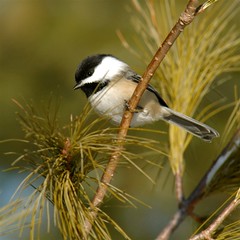• Chickadees tend to feed one at a time because there is a hierarchy that allows the most dominant bird to feed first. Generally, chickadees take one seed from the feeder – sometimes choosing with care to get the heaviest seed – and then fly away to eat it and return for more. Their favorite food is oil sunflower seed, but they also eat striped sunflower seeds, peanuts and suet.
.
• Chickadees are inquisitive and found in wooded areas across much of North America. The more common species include the Black-capped, Carolina and Mountain Chickadees.
.
• Chickadees weigh less than half an ounce and are identified easily by their namesake call “chick-a-dee.”
.
• Chickadees are generally monogamous and stay with the same mate for life. They will excavate their own nest site in rotten or decaying wood or use an old woodpecker hole or use a nesting box.
.
.
• Chickadees watch other birds’ foraging habits to see if they should adapt their behavior to be more successful. Though chickadees are regular visitors to feeders, over 75% of their winter food supply still comes from natural sources.
.
.
 Image by jackanapes via Flickr• Chickadees do not migrate and are equipped to survive harsh winter weather. They cache foods and remember where they are hidden, have dense winter coats, diligently find excellent, well-insulated roosting cavities and can perform a regulated hypothermia to conserve energy overnight.
Image by jackanapes via Flickr• Chickadees do not migrate and are equipped to survive harsh winter weather. They cache foods and remember where they are hidden, have dense winter coats, diligently find excellent, well-insulated roosting cavities and can perform a regulated hypothermia to conserve energy overnight..
• When the temperature falls below 10º F, research has shown that the survival rate of chickadees almost doubled when they had access to feeders.
.
• Chickadees can gain as much as 10% of their body weight each day and lose it all again during a cold winter night.
.
Source: WBU BOTM
Category ›
Bird of the week
 Unknown
Unknown
 Saturday, September 11, 2010
Saturday, September 11, 2010










No comments:
Post a Comment